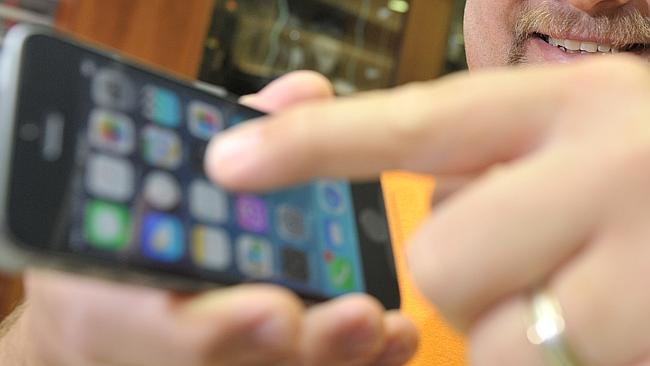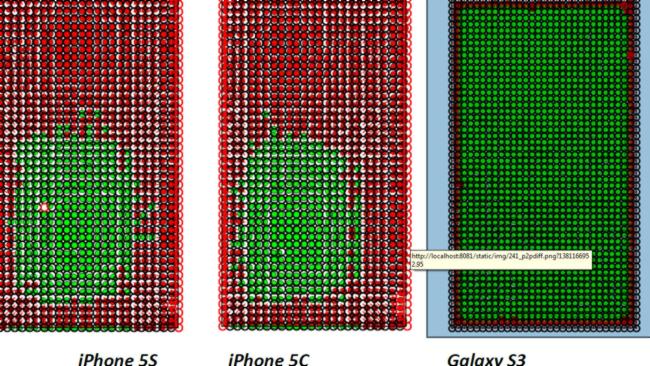
Those of you who’ve used an iPhone, particularly the later models, will probably have noticed the same kind of thing as we have. That is, the digitiser really isn’t all that good, and your perceived inaccuracy of your typing can leave one feeling quite annoyed.
Well, Finnish firm OptoFidelity have used a robot and a robotic finger, and compared the touch sensitivity of the newest iPhone handsets, the iPhone 5C and iPhone 5S, with a slightly older, yet extremely popular, Samsung Galaxy SIII. While Samsung’s phone is a good deal older than the Apple models, never fear.

Take a look at the image above. It shows the results of OptoFidelity’s testing, and as you can see, while the Galaxy SIII can accurately record your touches across the entirety of his touch screen, the iPhone fares far worse. In fact, looking across the area typically occupied by a keyboard on a touchscreen, you can see that an iPhone would likely misinterpret your attempts to touch the Q, I, O or P keys, especially if your not touching them precisely in the middle of the key. Contrast this performance with the Galaxy SIII, which seems to perform equally well across the whole screen, and soon you’re able to see why an iPhone relies so heavily on its auto-correct. Frankly, its touch accuracy really isn’t that good.
It’s not all bad news though, because one needs to consider the parameters of the test. The test environment registered a fail (or a red mark) where the position registered was more than 1mm off from the reported coordinates from the artificial finger. Pass marks (i.e. an accuracy to 1mm) were marked green.
One needs to bear in mind that we don’t have 1mm wide fingers. In fact, some of our fingers are much wider than this, and there’s a good change that even a moderately inaccurate digitiser will have the software smarts behind it to accurately interpret what you’re trying to touch.
It’s interesting to note though, that the inaccuracies some of us have experienced on iPhones might not just be a function of the smaller (and narrower) screens, but also the actual hardware/software combination behind them as well.
Bet you’re glad you chose an Android device now, huh?




Uhhh i actually have been amazed by my ipod’s touch accuracy. Ive barely ever clicked a tiny 4×4 pixel button with my fat finger and miss it. Whereas with my samsung note 2 even large buttons need careful pressing and smaller buttons are physically impossible to successfully click on the first 20 tap attempts.
This article is absolutely ridiculous. Apple’s touch accuracy is genius while samsung’s is atrocious.
Somehow im getting the feeling that the article was written by a samsung employee
I have never owned an iPhone but what I can say is that the iPad sensor is shockingly bad. Trying to hit the Done button in the G+ app is more miss than hit.
Guys this is a pretty terrible article. It’s widely known that iOS corrects for the angle of view. Just look at the methodology of the test – 90° angle. How many of you use your phone at an arms length touching at exactly 90°? Want an easy demonstration? Grab an iPhone and do some basic navigation in front of you. Now flip it around to face somebody on the other side of the table. Now try the same exercise, you’ll find you need to adjust for the compensation. I get that this is an android fan site but don’t pick… Read more »
I expect better from Ausdroid. Hopefully the N5 and 4.4 will actually get released so they’ve got something to actually post about.
The iPhone screens always seem more immediately responsive to touch, and there’s a few studies out there showing it. Maybe there’s a tradeoff of speed/accuracy going on here?
Well…Apple defenders would claim that it was DESIGNED to be inaccurate at the top portions as the iPhone is typically held at an angle in use. Hence to counteract parallax errors from the angled viewpoint of the user, the digitiser registers the input slightly below the perceived point of contact. This also explains why the lower portions closer to the user has more correlated contact. They claimed the above test was done by a robotic finger hitting the screen at 90 degree which in all likelihood isn’t the normal use case scenario for the typical finger. Then again, Apple apologists… Read more »
i use both iPhone (Work) and Android for my personal device. The iPhone is inferior in almost every way however the thing that kills me is that the digitizer is completely inaccurate. it is nice to know that there is some science backing me up on this rather than be thinking it was just because i have fat fingers.
The Q, I, O and P misses are so true. I used to have that problem when I had an iPhone.
I think we all have had that problem. I assumed it was large hands.. but no, seems it’s just rubbish hardware, designed for one particular use case and unsuitable for others. At least Android is fairly hand-position agnostic.
“designed for one particular use case and unsuitable for others. At least Android is fairly hand-position agnostic.”
What particular use case is that? Hand position agnostic?
What on earth are you on about?
It’s simple really. An iPhone is optimised to be used in one position, that is, angled in the hand and probably not at a 90° angle, probably a bit shallower. However, we don’t always use our phones in this orientation. What if it’s on a desk, or in a stand, or a car holder (while you’re parked of course..). While this test really isn’t all that scientific, or based in real life usage, it does show one thing.. To my mind, a screen that is equally sensitive across its whole area is more likely to be accurate across a range… Read more »